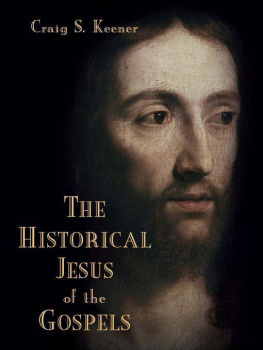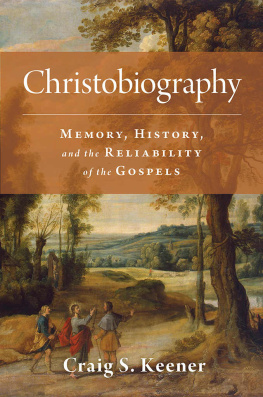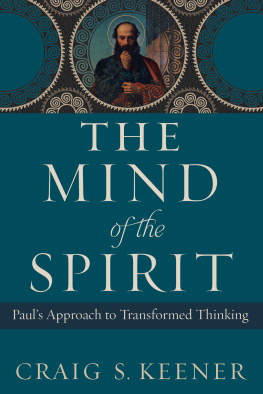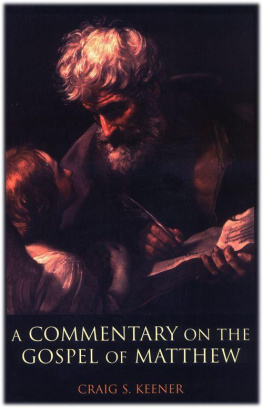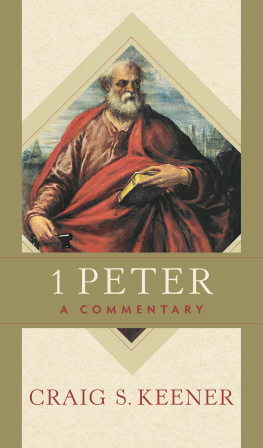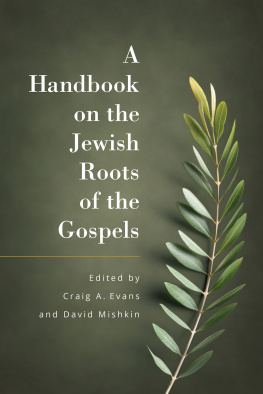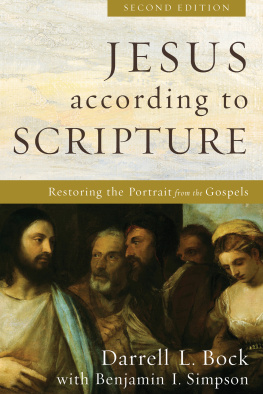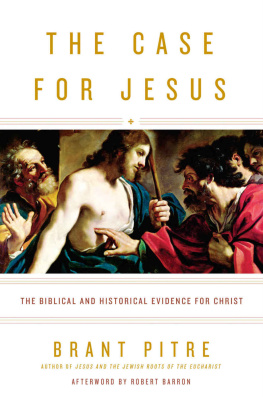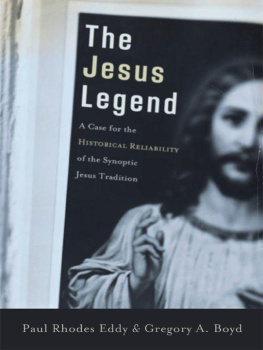Table of Contents
2009 Craig S. Keener
All rights reserved
Published 2009 by
Wm. B. Eerdmans Publishing Co.
2140 Oak Industrial Drive N.E., Grand Rapids, Michigan 49505 /
P.O. Box 163, Cambridge CB3 9PU U.K.
Printed in the United States of America
14 13 12 11 10 09 7 6 5 4 3 2 1
Library of Congress Cataloging-in-Publication Data
Keener, Craig S., 1960-
The historical Jesus of the Gospels / Craig Keener.
p. cm.
ISBN 978-0-8028-6292-1 (cloth: alk. paper)
1. Jesus Christ Historicity. I. Title.
BT303.2.K45 2009
232.908 dc22
2009029275
www.eerdmans.com
To E. P. Sanders and James H. Charlesworth
Abbreviations
Abbreviations employed in the Bibliography of Sources Cited
Acknowledgements
Special thanks to Eerdmans and especially Michael Thomson for welcoming this manuscript; to Jenny Hoffman and others for their editorial work; also to Diane Chen, my esteemed colleague in New Testament at Palmer Seminary, for her helpful feedback on it. I am also grateful to Richard Bauckham, Craig Evans, and others whose comments prompted me to undertake this book. I also gratefully acknowledge permission from Hendrickson Publishers to reuse relevant material from my John and (forthcoming) Acts commentaries (especially, though not exclusively, in chs. 6-8, 10). Many other parts of this volume build on material found in my Matthew commentary for Eerdmans.
Preface
When scholars speak of historical Jesus research, they mean especially what we can infer about Jesus from purely historical study. Yet a major key to how we reconstruct the historical Jesus involves the sources we use to decide what we know about him. Scholars who depend largely on sources from the second century (such as the Gospel of Thomas ) or later (such as the Secret Gospel of Mark, probably a twentieth-century forgery) will reconstruct the Jesus of history differently than scholars who depend primarily on Mark, Luke, and Matthew. The central and most important part of this book thus focuses especially on the questions of our sources, particularly on the potential reliability of our earliest sources.
Beyond that, this book samples some key themes, sayings, and actions that we can attribute to Jesus with a high degree of probability. It should be understood that when historians speak in terms of probability, we speak only of what can be ascertained by historical methods. We lack historical evidence for most of what has happened in history; no one claims that nothing happened except what we can demonstrate by historical means. As scholars often point out, studies concerning the historical Jesus merely sort available historical evidence according to historical methods; they cannot bring us fully face-to-face with the Jesus who lived, taught, and died in the first century CE. They are useful, however, in providing a way that historians as historians can talk about Jesus, and a critical minimum of assumptions that both Christians and non-Christians can use in dialogue about Jesus.
Dedication
I have dedicated this book to Ed Sanders and Jim Charlesworth. I had once dreamed of studying with Geza Vermes and especially E. P. Sanders at Oxford, but, knowing that this dream was financially impossible for me, I applied instead to Princeton, Duke, and Yale. Of the three, Princeton was initially my first choice, because I desired to study with James Charlesworth; yet I ended up at Duke, which had its own strong set of advantages (not least of which was that they accepted me into their program). Providentially (from my perspective), Ed later interviewed at Duke, and I met him when, as Orval Wintermute was giving him a tour of the campus, they visited the classics reading room where I was then working through Epictetus.
After Ed took the position at Duke, I had the privilege of being his graduate assistant, hence hearing him engage undergraduates as well as my fellow graduate students. From one of his earlier books, I had expected him to be harsh, but soon discovered that some of his more graphic statements were intended rhetorically, to hold attention (not infrequently in a humorous way). He was thoroughly supportive of his students, fair toward us when we disagreed, and has remained kind and supportive in the years following. I do not expect him to agree with everything in this book (though I think I have agreed with him more often than disagreed), but I trust that he will recognize his seminal influence on me, as well as on a generation of scholars working in Jesus research from an especially Jewish context.
I met James Charlesworth briefly when I visited Princeton before my doctoral work, but have gotten to know him more fully in more recent years. Although I did not have the privilege of studying with him in person, he has nevertheless shown great kindness and generosity in welcoming my scholarship. His work on different aspects of early Judaism and Jesus research, as well as his collaboration with and organization of a broad range of scholars for numerous important projects, has likewise helped to shape the current generation of scholarship in these areas. (Not least, Jims industry in organizing the massive Pseudepigrapha project has preserved many of us from depending too much on earlier translations published nearly a century ago.) Again, I do not presume that either scholar will agree with every decision I have made in the book (no two scholars agree on everything anyway), but I remain grateful for their example and support.
This Books Genesis
A range of ancient sources from treaties to forensic speeches often opened with a narrative explaining the events leading up to the present situation. Such an explanatory narrative seems in order here.
This book would not exist apart from conversations with Richard Bauckham and Craig Evans in April 2007. This book rests especially on detailed research into the Gospels, research with which some of my earlier readers will be familiar. I had already invested considerable time in historical Jesus scholarship, but (despite a publishers urging) had long refused to add to the plethora of books on the subject. Instead, I published my research on the subject in my Matthew and John commentaries (in the introduction and appropriate passages). Nevertheless, I hoped that my research would provide useful fodder for others working in the discipline, including those addressing some of the misinformation popularly propagated about Jesus in recent years, which has often ignored his Jewish setting.

